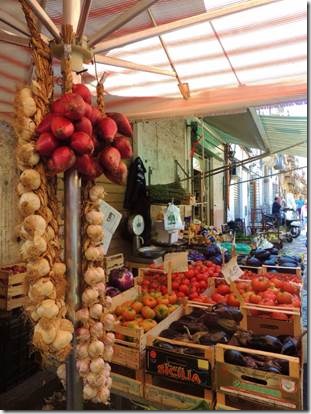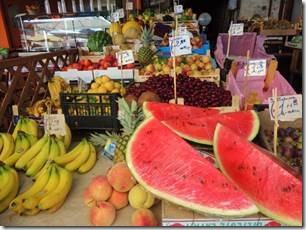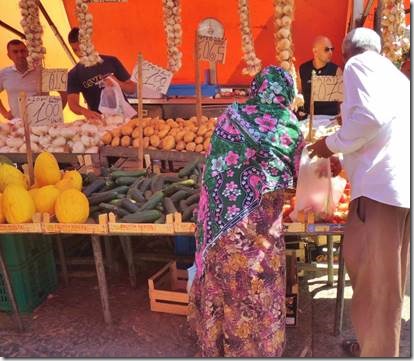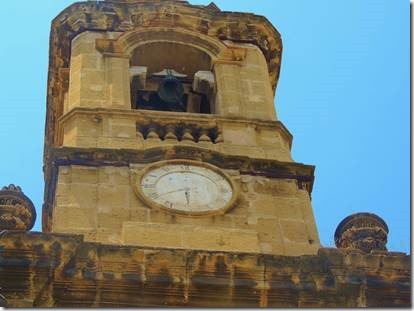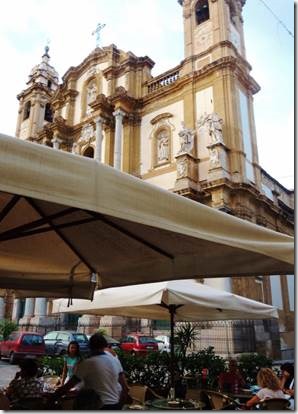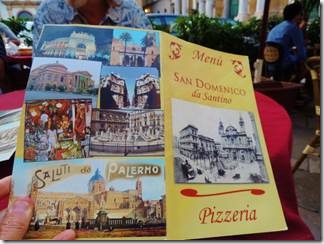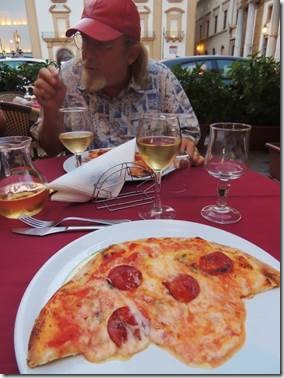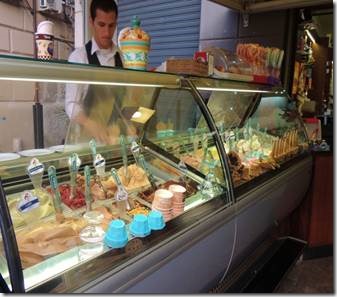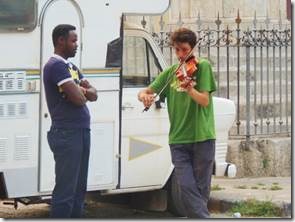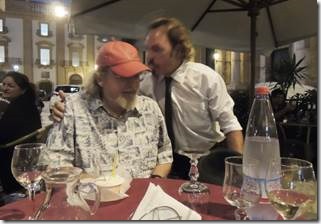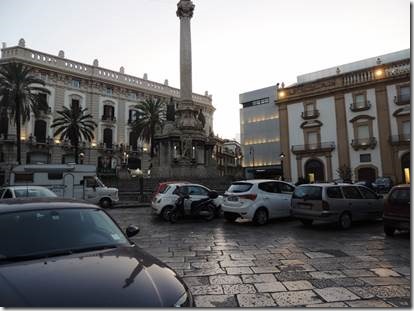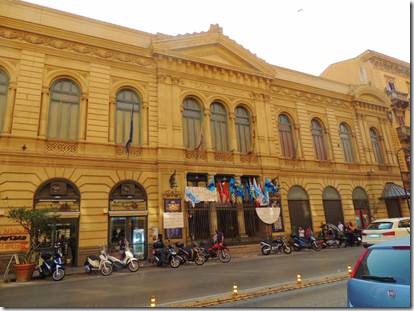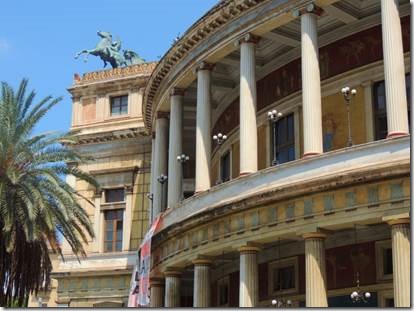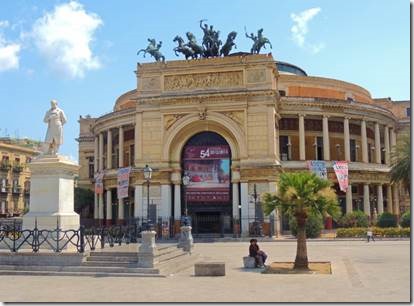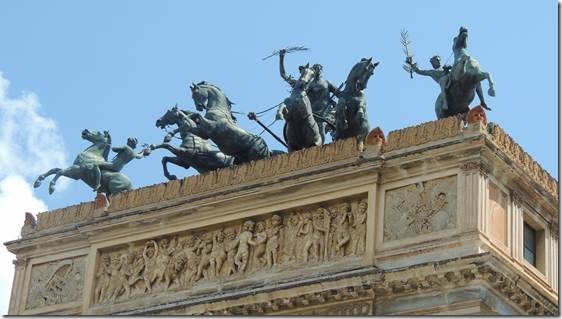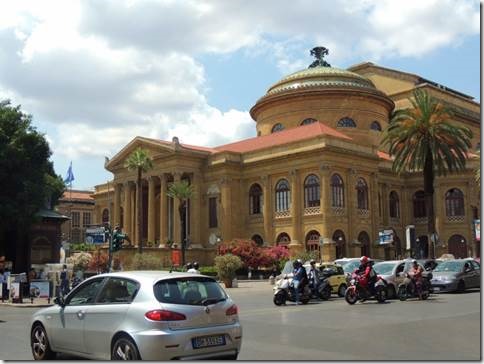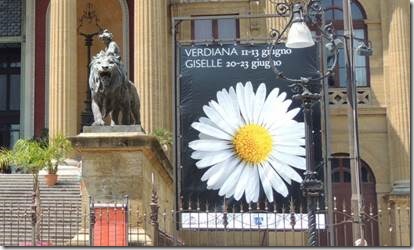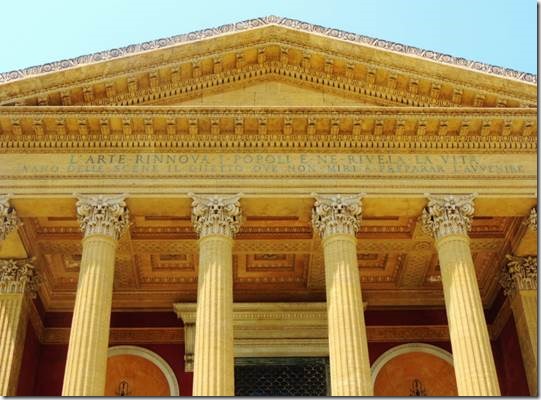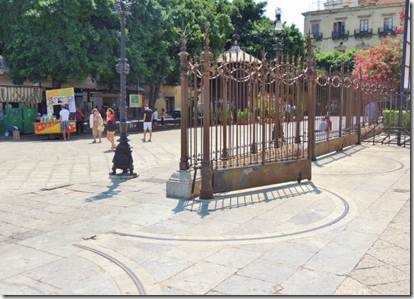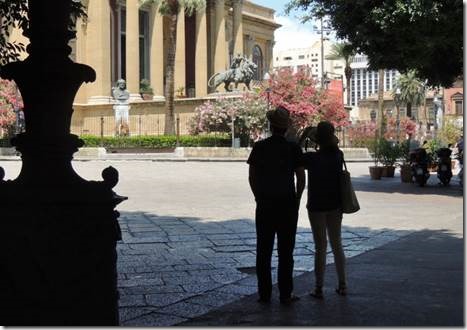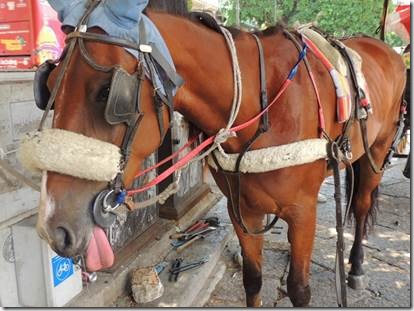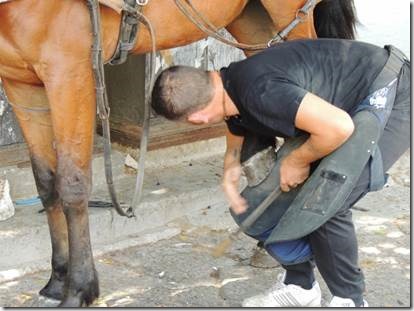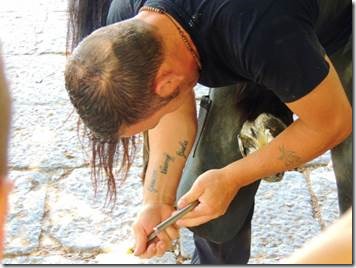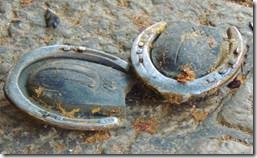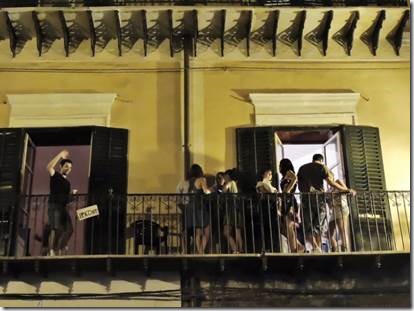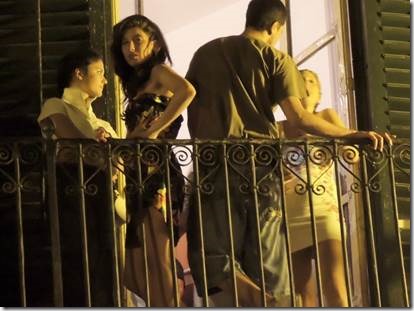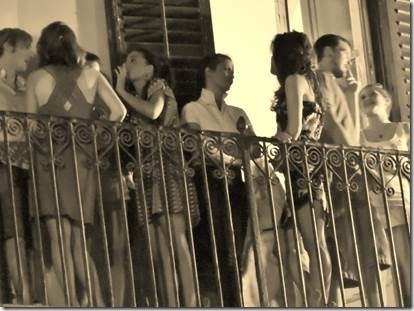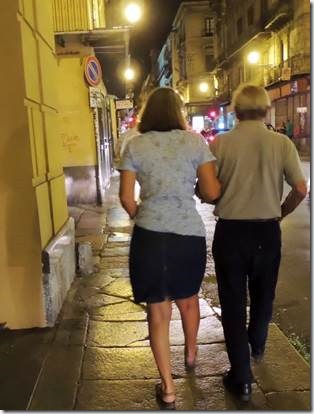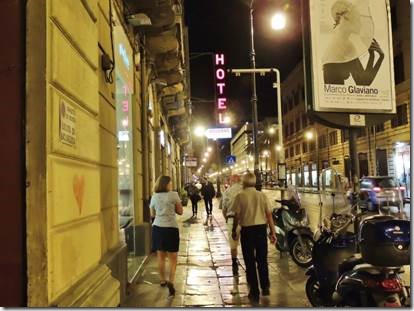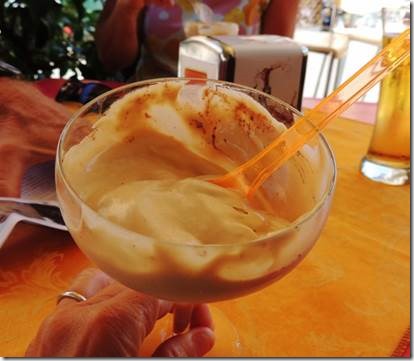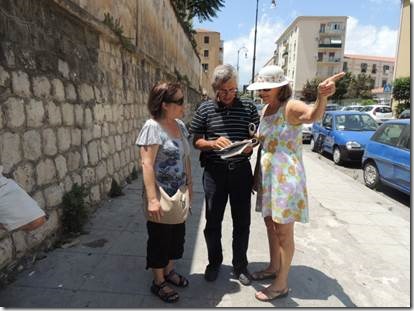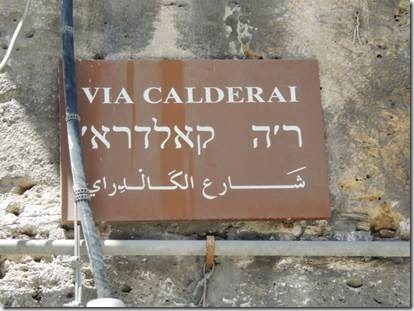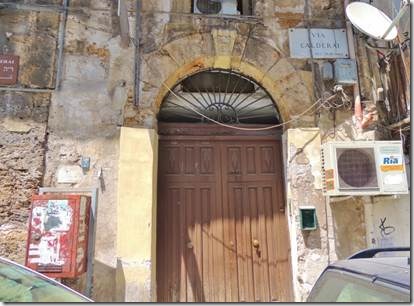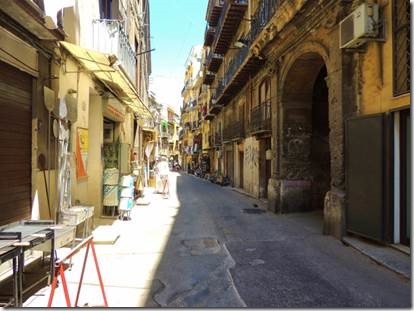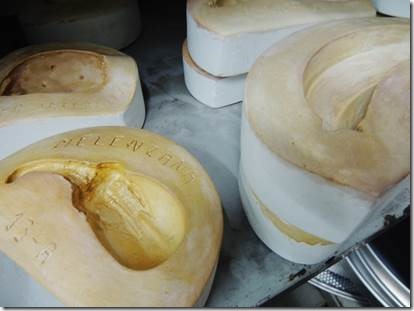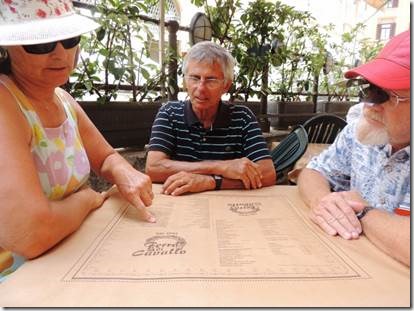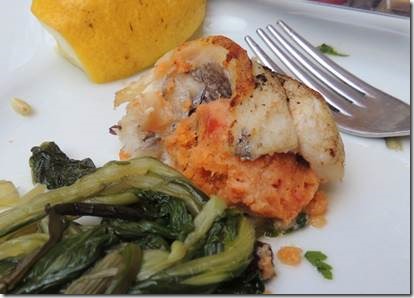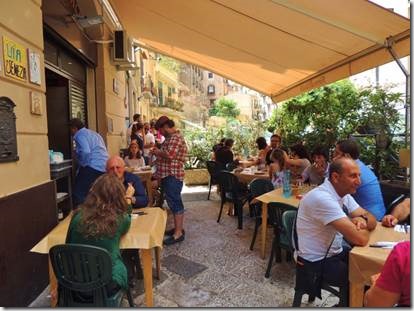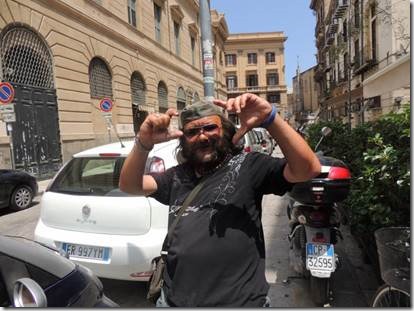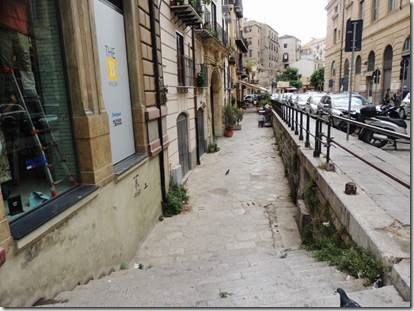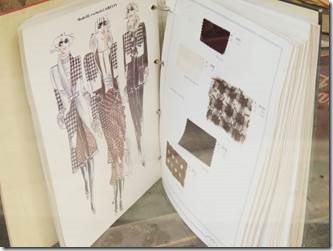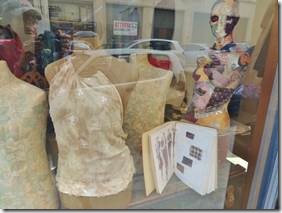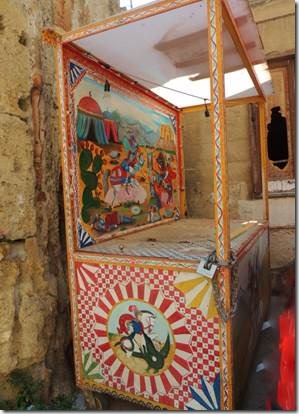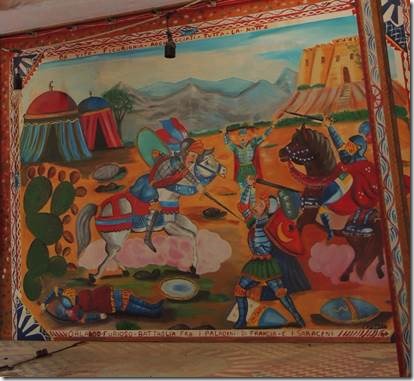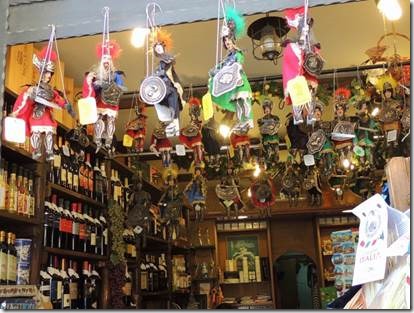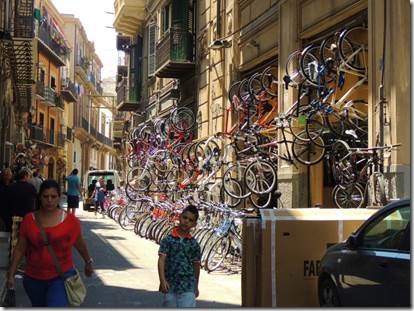Aslama
As soon as I hit, SEND, it’s off to the shower and get packed and ready to hit the Tunisian roads. Not 100% sure where we’re going but ..south probably to Al Djem and the Roman ruins first. Then we’ll see. I’ve one more Palermo after this and some Licata photos…so I’m beginning to feel like the white rabbit and racing like mad.
Ru
Street Scenes and Eating in Palermo # 2
|
Lovely garlic! |
|
The clock on the tower is painted on! |
|
Our favorite pizza place just almost across from our hotel. We ate dinner our last night and then lunch the next day before heading to the bus station. Pizza, pasta, pastry = pounds that I’m trying to get rid of here in Tunisia. So far a lovely salad Nicoise at a marina café and a grilled fish at a Hammamet restaurant Jo and Mick showed us last night. |
|
My half of our dinner sausage pizza. Lunch we split a prosciutto, cheese, and basil pizza. Pizza isn’t available until the ovens are fired up as we found during our lunch visit: we waited the half hour. But gelato is anytime, everywhere, any and every flavor. I actually only had it one time during our road trip and it really is wonderful creamy stuff. |
|
Pizza plaza entertainers We were serenaded by a violinist as one should be in Italy and tricked by a magician. Both earned some lira for their performances, hence Randal being hugged. |
|
The pizza place plazza |
|
Teatro Biondo, just down from our hotel http://www.teatrobiondo.it/default.aspx (Italian only) “In the middle part of the magnificent Via Roma, one will see the church called St. Antonio Abate and right in front of it, next to the elegant neoclassical facade of Palazzo Arezzo, stand the beautiful Teatro Biondo. Founded in 1903 when Palermo was experiencing a cultural revival, Teatro Biondo was Palermo’s first opera house, also hosting circus performances. Today, the theater hosts mostly plays and many of Italy’s most famous actors and best theater companies have graced Biondo’s stage” Owner description: Teatro Biondo represents the ultimate expression of architecture in nineteenth-century Theater in Palermo, concluding a formidable urban sprawl that had had its most significant stages in the implementation of the Teatro Massimo and Teatro Politeama. Between late ‘800 and early ‘900, in fact, the city lived a particular moment of glory thanks to an enlightened entrepreneurial bourgeoisie, led by the Florio family, and a class of intellectuals. |
|
The last places we visited….. Every morning Randal and I would meet with Linda and Frank and go off around Palermo seeing stuff and then having a late lunch. Then it was siesta time with plans to re-meet for dinner about 8pm. Late afternoons I’d walk, Randal would compute and Linda and Frank would do their own thing. While out and about they found the two lovely huge Palermo theaters but Linda didn’t have her camera. So our final morning after our visit to Blue Mary, Linda and I raced over to see the theater facades and take some photos. We were back at the pizza place by noon only to wait until 12:30 when pizza was available to be ordered. After our race around Palermo she and I deserved our pizza. |
|
Teatro Politeama on Piazza Politeama – Politeama Theatre – Built in neoclassical style, which was in vogue at the end of the Eighteen Hundreds, the Politeama Theatre illuminates the Piazza which shares its name. Designed as a "polytheama", or performance space for a variety of shows, its role in Palermo was to be as central to social life then, as cinema is now. Equestrian exhibitions, gymnastics, acrobatics, operettas, plays, and social festivities were to be held and seen there. Just before the Politeama was built, moral in Palermo was low after an epidemic of cholera. The city needed a boost, and the authorities, already in favour of building a people’s theatre, encouraged construction despite budget restrictions. In fact it was completed thirty years before the operatic, more aristocratic Theatre Massimo. Following the ancient theme of entertainment for the masses, the Politeama is structurally reminiscent of Greek and Roman traditions: circular, with ambulatories supported by Doric and Ionic columns, originally made for open air shows. The outside is decorated with a frieze depicting circus performers. The façade is deigned like a Roman (or Napoleonic) triumphal arch, echoing the Hellenic design of the theatres of Pompeii. A bronze horse drawn quadriga driven by figures representing artistic Talents, by Mario Rutelli, gallop across the theatre roof; Rutelli was also known for the Naiads Fountain in Piazza della Repubblica in Rome. The theatre’s construction did not run smoothly. Economic, municipal and administrative setbacks hindered building, which, for a while, was completely suspended. At its final inauguration in 1874, the theatre was still roofless. However, by 1891 it was complete, with a seating capacity of 5000, and a truly inspirational roof, facilitating fantastic acoustics, even if, by the original project, the theatre was designed to be uncovered. Now the top floor is a museum: the Modern Art Gallery "Empedocle Restivo", used to exhibit the works of artists from the Eighteenth and Nineteenth century. http://www.italyguides.it has a 360 view of the piazza. |
|
The dancing babies from Ally McBeal! |
|
Teatro Massimo http://www.teatromassimo.it/index_en.php http://www.teatromassimo.it/teatro/launch_en.swf site is quite the experience to visit The Teatro Massimo Vittorio Emanuele in Palermo opened its doors to the public on the evening of 16 May 1897, twenty-two years after the solemn public ceremony of the laying of the first stone. This took place on 12 January 1875, and ended a chequered series of vicissitudes with interminable squabbles lasting over ten years. The international competition for the project and realisation of the opera house had been announced by Palermo Council in 1864, and its prime mover was the mayor, Antonio Starrabba di Rudinì. For a long time there had been talk of building a big new theatre in Palermo, worthy of the second biggest city in southern Italy after Naples. Palermo, in the second half of the nineteenth century, was engaged in getting itself a new identity in the light of the new national unity. Cultural life was influenced by the new national physiognomy and the positive consequences of the activity of enlightened entrepreneurs like the Florios, who also made generous donations to the building of the opera house and for some years were also its no less enlightened managers. Intense commercial relations led to the convergence and development in Palermo of interests with a European dimension and caused the city to be continually in touch with different cultural models than its own. This was the start of the Belle poque, which for the city was a time of cultural and economic rebirth which became mythical and was only to be interrupted by the outbreak of World War I. http://www.teatromassimo.it/teatro/launch_en.swf Scenery on sale The Teatro Massimo puts on sale a number of scenery materials from its productions. A complete list is available through the Purchase Department. Wish we’d had time for the guided tour and perhaps a go at the scenery sale! |
|
Lions stand guard just like the New York Public Library |
|
Art renews people and reveals life…or something like that. |
|
The big iron gates rode on a track to open and close |
|
Looking back at the bust of Verdi |
|
The performance just in front of the theater. I think this tongue thing was the horse’s own doing. I know there are nose twitches used when a horse just won’t behave, but not a tongue twitch. Plus the horse was quite calm and relaxed even with the small crowd that was watching him get new shoes. |
|
Getting new shoes |
|
Pony tail and discarded shoes with rubber padding. The smith doesn’t have a strange hair style, that’s the horses tail behind his head. |

